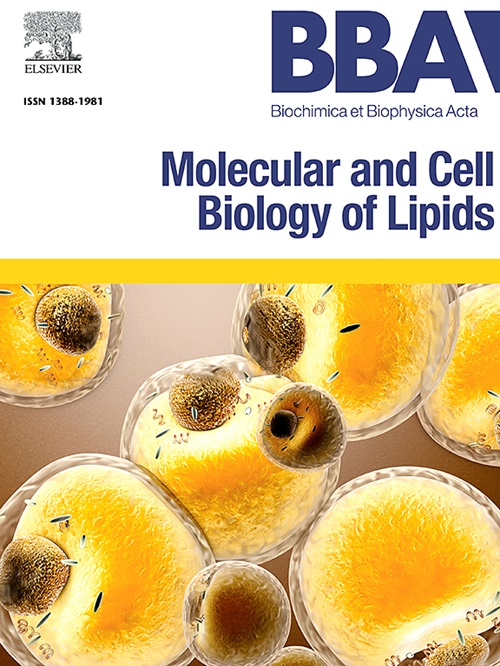核桃油作为饮食干预动脉粥样硬化:功效和机制途径
IF 3.3
2区 生物学
Q2 BIOCHEMISTRY & MOLECULAR BIOLOGY
Biochimica et biophysica acta. Molecular and cell biology of lipids
Pub Date : 2025-03-08
DOI:10.1016/j.bbalip.2025.159607
引用次数: 0
摘要
背景与目的核桃油(WO)和花生油(PO)是富含不饱和脂肪酸的常见植物油,具有缓解动脉粥样硬化(AS)和降低心血管疾病(CVD)风险的作用。与PO相比,WO含有更高比例的多不饱和脂肪酸(PUFAs)。本研究旨在探讨WO对AS的影响并阐明其潜在机制,为加强WO在功能食品和药物中的应用提供理论依据。方法采用高脂饲料和维生素D3注射大鼠建立sa模型。大鼠以1.2 g/kg的剂量灌胃WO或PO,连续4周。评估血脂水平和动脉损伤,并对大鼠脉管系统进行转录组学和代谢组学分析。结果白藜芦醇和白藜芦醇均能显著降低大鼠血脂水平和动脉粥样硬化指数,减轻动脉壁损伤和斑块形成。WO表现出更明显的效果,特别是在降低血清TG、TC、hdl和LDL-C水平方面。转录组学分析表明,脂肪酸、氨基酸代谢在高脂肪饮食导致的AS发育中起着至关重要的作用。代谢组学分析表明,WO处理后大鼠的精氨酸、脯氨酸、半胱氨酸、蛋氨酸、甘氨酸、丝氨酸和苏氨酸的代谢发生了显著变化。结论wo和PO通过调节脂质代谢,影响TCA循环和半胱氨酸-蛋氨酸代谢等关键代谢途径,有助于缓解AS。更显著的影响表明其作为预防和治疗as的膳食补充剂的潜力。本文章由计算机程序翻译,如有差异,请以英文原文为准。
Walnut oil as a dietary intervention for atherosclerosis: Efficacy and mechanistic pathways
Background and aims
Walnut oil (WO) and peanut oil (PO) are common vegetable oils rich in unsaturated fatty acids, known to alleviate atherosclerosis (AS) and reduce the risk of cardiovascular diseases (CVD). WO contains a higher proportion of polyunsaturated fatty acids (PUFAs) compared to PO. This study aimed to explore the influence of WO on AS and elucidate its potential mechanisms, providing a theoretical basis for enhancing the application of WO in functional foods and pharmaceuticals.
Methods
AS was established in rats using a high-fat diet and vitamin D3 injections. Rats with AS were administered WO or PO via gavage at a dose of 1.2 g/kg for 4 weeks. Serum lipid levels and arterial injury were assessed, and transcriptomic and metabolomic analyses of the rat vasculature were performed.
Results
Both WO and PO significantly lowered serum lipid levels and the atherogenic index (AI) in rats, reducing arterial wall injury and plaque formation. WO exhibited a more pronounced effect, particularly in decreasing serum levels of TG, TC, HDL![]() C, and LDL-C. Transcriptomic analysis indicated that fatty acid, amino acid metabolism were crucial in AS development due to a high-fat diet. Metabolomic analysis indicated significant changes in the metabolism of arginine, proline, cysteine, methionine, glycine, serine and threonine in rats treated with WO.
C, and LDL-C. Transcriptomic analysis indicated that fatty acid, amino acid metabolism were crucial in AS development due to a high-fat diet. Metabolomic analysis indicated significant changes in the metabolism of arginine, proline, cysteine, methionine, glycine, serine and threonine in rats treated with WO.
Conclusion
WO and PO help alleviate AS by regulating lipid metabolism and influencing pivotal metabolic pathways like TCA cycle and cysteine-methionine metabolism. The more significant impact of WO indicates its potential as a dietary supplement for preventing and treating AS.
求助全文
通过发布文献求助,成功后即可免费获取论文全文。
去求助
来源期刊
CiteScore
11.00
自引率
2.10%
发文量
109
审稿时长
53 days
期刊介绍:
BBA Molecular and Cell Biology of Lipids publishes papers on original research dealing with novel aspects of molecular genetics related to the lipidome, the biosynthesis of lipids, the role of lipids in cells and whole organisms, the regulation of lipid metabolism and function, and lipidomics in all organisms. Manuscripts should significantly advance the understanding of the molecular mechanisms underlying biological processes in which lipids are involved. Papers detailing novel methodology must report significant biochemical, molecular, or functional insight in the area of lipids.

 求助内容:
求助内容: 应助结果提醒方式:
应助结果提醒方式:


